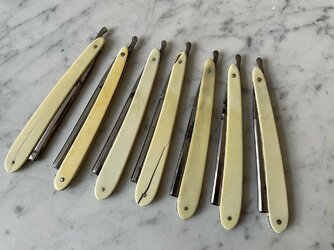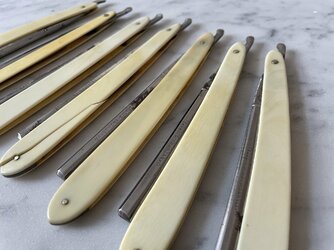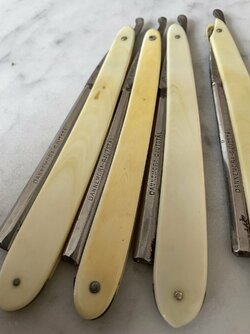Hi everyone,
I am posting here as a new member (and totally newbie to the world of straight razors), as following some research on Google it seems to be the best place to ask questions about C.V. Heljestrand (I've read that a certain Polarbeard is the master of knowledge ).
).
So, here's the story:
Years ago I have inherited from my grandfather a seven day set from the brand "C.V. Heljestrand".
The razors have the names of the days engraved on the back of the blade (I assume they are written in Swedish) and ivory handles (I assume), two of which are unfortunately split. Below the brand name are the words "Ekilstuna Prisbelönt". The blades (except for two of them) are engraved with city names and dates, as well as the "flat part" where there is a notch for the fingers (pardon my lack of technical vocabulary ).
).
On the "flat part" (on one of the razors) I read: 1867, Paris 1855, Stockholm 1866, London 1857. On the blade it is more difficult to read (it seems they have been fairly used), but I can distinguish Paris 1866-186[7], Bogota 1874, Stockholm 1866, Philadelphia 18[76] + some other incomplete names.
There is a symbol in the middle of the blade, masonic style. On the curved edge of the blade, the inscriptions "Dannemora Gjustal". The whole thing is in a leather box, with no inscriptions.
My grandfather was born in Hungary and was part of the aristocracy. He flew the country with his family when he was around 16, at the end of WWII when the country was occupied by the USSR. He then went on to live in Belgium for a short while and then moved to Canada (started working on the laying of railways there) and finally came back to Belgium for the rest of his life. I would assume this is a piece of item dating back from his time in Hungary (or maybe from his father). Unfortunately, I did not manage to get any information from him on this set.
Hence, here's why I am now contacting you guys, to see if anyone could help identifying these blades and provide knowledge as to their history, etc.
Here are the pictures. Feel free to ask for details.
Cheers
Alex






I am posting here as a new member (and totally newbie to the world of straight razors), as following some research on Google it seems to be the best place to ask questions about C.V. Heljestrand (I've read that a certain Polarbeard is the master of knowledge
So, here's the story:
Years ago I have inherited from my grandfather a seven day set from the brand "C.V. Heljestrand".
The razors have the names of the days engraved on the back of the blade (I assume they are written in Swedish) and ivory handles (I assume), two of which are unfortunately split. Below the brand name are the words "Ekilstuna Prisbelönt". The blades (except for two of them) are engraved with city names and dates, as well as the "flat part" where there is a notch for the fingers (pardon my lack of technical vocabulary
On the "flat part" (on one of the razors) I read: 1867, Paris 1855, Stockholm 1866, London 1857. On the blade it is more difficult to read (it seems they have been fairly used), but I can distinguish Paris 1866-186[7], Bogota 1874, Stockholm 1866, Philadelphia 18[76] + some other incomplete names.
There is a symbol in the middle of the blade, masonic style. On the curved edge of the blade, the inscriptions "Dannemora Gjustal". The whole thing is in a leather box, with no inscriptions.
My grandfather was born in Hungary and was part of the aristocracy. He flew the country with his family when he was around 16, at the end of WWII when the country was occupied by the USSR. He then went on to live in Belgium for a short while and then moved to Canada (started working on the laying of railways there) and finally came back to Belgium for the rest of his life. I would assume this is a piece of item dating back from his time in Hungary (or maybe from his father). Unfortunately, I did not manage to get any information from him on this set.
Hence, here's why I am now contacting you guys, to see if anyone could help identifying these blades and provide knowledge as to their history, etc.
Here are the pictures. Feel free to ask for details.
Cheers
Alex




 I knew I was right to post here to find experts!
I knew I was right to post here to find experts! 




